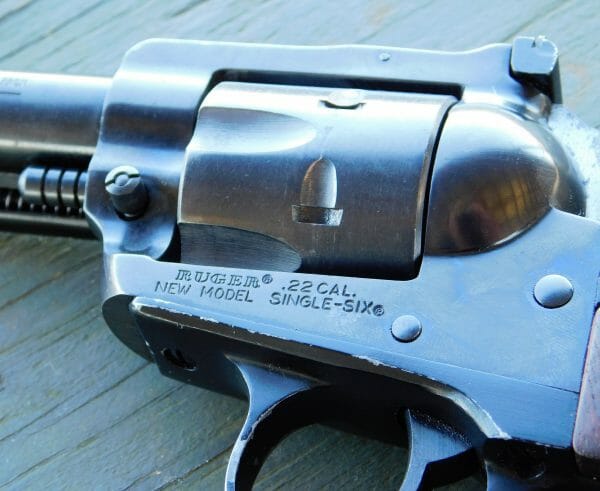
The Ruger Single Six hearkens back to the popularity of TV Westerns that came with the dawn of television in the households of ordinary Americans in the 1950s. Back then, Ruger was a newcomer to the game–not the giant it is today. Colt stopped producing their legendary Single Action Army Revolver so they could focus on production for World War II contracts. By the time Colt got around to starting production again, Ruger and others showed up with their own single-action designs at the same time when those neat TV shows were generating renewed interest in the guns the cowboys and lawmen carried. Among these new competitors was the Single Six, which mated proven, timeless lines with new manufacturing techniques paired with a useful cartridge anyone could shoot–the 22 LR.
The gun sold well, but like those old Colt Single Actions, there was no drop safety to prevent the hammer from setting off a round under the hammer. Old convention states loading five in a six-shooter so that the gun can be carried safely on an empty chamber, but Ruger incorporated a transfer bar safety in the 1970s that prevented the firing pin from striking the primer unless the trigger was actually pulled by the user. Though not the first drop safety, this transfer bar setup is one we can see the world over today. This, among other changes like switching from screws to pins in the grip frame, has come to embody the current itineration available today, the New Single Six.
Ruger Single Six Revolver
My Ruger New Single Six came as a pawnshop find. The gun had some wear on the bluing, mild rust on the hammer, and flaked enamel on the aluminum grip frame in places. I am not much of a single-action revolver fan, but I did cut my handgun teeth on Ruger single actions—not to mention the price was right. So it came home.
The first thing you will notice in the hand is that the Single Six is a beast of a handgun for a 22. At 35 ounces, it weighs as much as a conventional 357 Magnum handgun. The aluminum grip frame and walnut grips were well-formed and reminiscent of the feel of a Colt Single Action.
The Colts are known as naturally pointing guns and the same is true with the Single Six despite the Single Six wearing a thick 5.5-inch barrel and a bulky one-piece cast carbon steel receiver. The high profile adjustable rear notch and front, serrated post-sight arrangement even out the profile of the gun. The only obvious breakup in the lines of the gun is the top strap of the receiver where the barrel meets the receiver. Otherwise, the Single Six operates like those old Colts with a spring-loaded ejector rod housed under the barrel and a loading gate on the right side of the frame where rounds are loaded and unloaded one at a time until you have your six rounds into the cylinder.
My particular gun came in 22 LR, but the Single Six line has since grown to include nine and ten shot arrangements with carbon steel or stainless steel to choose from, numerous barrel lengths, and cataloged calibers like 17 HMR, 22 Magnum, and 32 H&R Magnum.
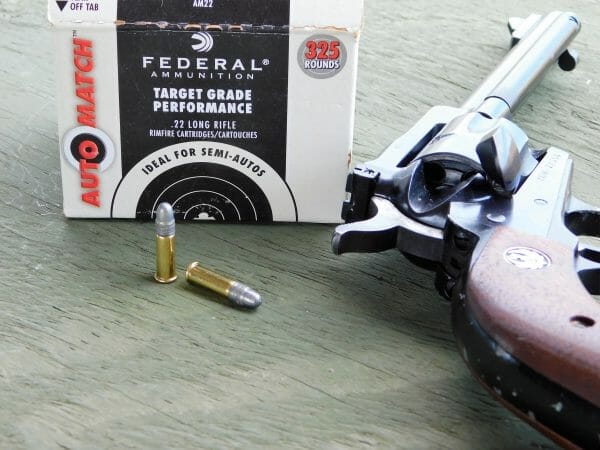
On The Range
If you want a trouble-free handgun right out of the gate, a good single-action revolver like the Single Six is a good choice. The only learning curve the gun really gives is loading and unloading, which happens to be my favorite part of the shooting experience. It loads like those old cowboy guns. The cylinder is freed by opening the loading gate. There is no need to half-cock the hammer to get the cylinder to spin. With the gate open, insert one round and rotate the cylinder to the next chamber. Repeat this until you have six rounds loaded. Unloading empty brass takes some finesse to line up each chamber with the ejector rod so you can run the rod through and punch out the empties. Even though this is more involved than loading a swing-out cylinder revolver, I never felt I was spending a ton of time loading the gun, but I did get to appreciate the experience, and I ran myself out of bulk pack boxes quickly.
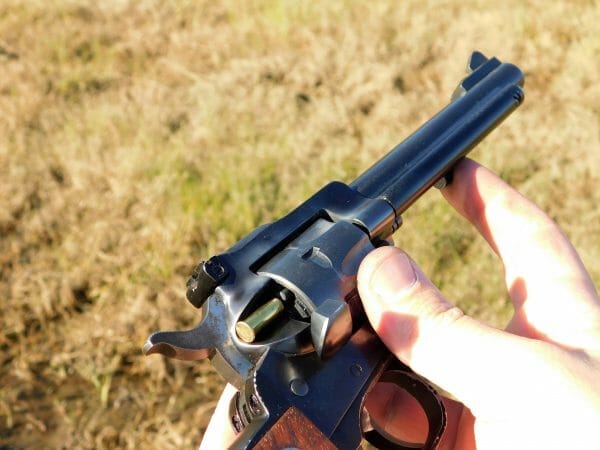
Like loading, firing the pistol can be done faster than you might think. The gun’s hammer has to be cocked for each shot, but the hammer is within easy reach for an average shooter, and the checkered hammer spur allows for a firm grip. Thanks to that Peacemaker-like grip, constant cocking didn’t upset my sight picture much at all, and I was back on target in no time. It did help that I am working with adjustable sights that pop out to the eye somewhat more than the fixed blade front/notch rear sighting arrangement of a typical single-action revolver.
On the range, shooting the New Single Six was pleasant, and I was apt to challenge myself by shooting small sixteen-ounce water bottles between thirty-five and fifty yards with some fairly surprising hits thanks to the gun’s point-ability, feel and a fairly crisp trigger pull. In fact, the lack of movement in that light trigger surprised me and I sometimes threw a few shots, but otherwise, there wasn’t much guesswork.
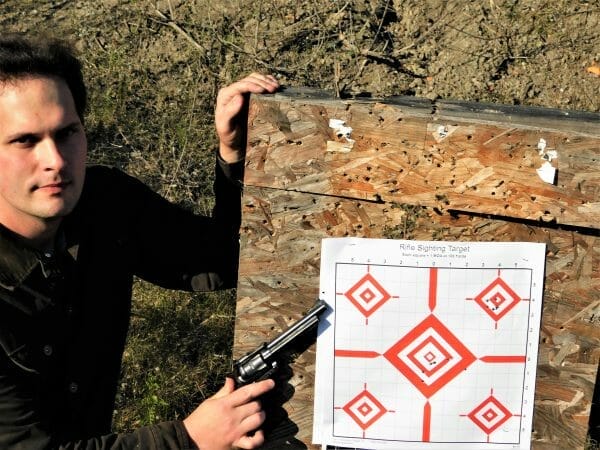
On paper, at twenty-five yards, I could put six rounds into a four-inch group and all rounds in one inch at ten yards, firing offhand with Federal Automatch 40-grain lead ammunition. CCI Blaser ammunition performed equally well, and Remington 40-grain Golden Bullets came a close third. With their lighter 30-grain bullets, CCI Stingers opened up the groups to about five inches at twenty-five yards.
Live Inventory Price Checker
|
|
Ruger Single-Six .22LR Revolver, 4.6" Barrel, Adjustable Rear & Ramp Front Sights, Blue - 623 | Palmetto State Armory | $ 730.99 $ 651.99 |
|
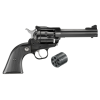
|
Ruger Single-Six .22LR Revolver, 4.6" Barrel, Adjustable Rear & Ramp Front Sights, Blue - 623 | Palmetto State Armory | $ 799.99 $ 599.99 |
|
|
|
Ruger Single-Six .22LR Revolver, 5.5" Barrel, Adjustable Rear & Ramp Front Sights, Blue - 621 | Palmetto State Armory | $ 730.99 $ 651.99 |
|
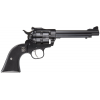
|
Ruger Single-Six .22LR Revolver, 5.5" Barrel, Adjustable Rear & Ramp Front Sights, Blue - 621 | Palmetto State Armory | $ 799.99 $ 649.99 |
|
A Best Buy? For What?
I usually find things I love and hate about a firearm in the middle of testing. The grip is too small, the safety should not be here, and the gun malfunctions with ammunition it should work with. In the case of the Ruger Single Six, what you see is what you get. The Six is a proven wheel gun, and it is probably best to chalk up what I say here as my own little referendum on a proven design.
Today, guns are chiefly associated as tools for “protection” or “safety.” This “defensive” mindset constantly frustrates me, as I feel it takes the fun out of ownership. Some are so concerned with having that hard-hitting self-defense gun that the fundamentals of shooting are neglected—or not counted on at all. In this environment, a good 22-caliber handgun like the Single Six is discounted.
As a good all-around tool, a 22 handgun can do many things besides punching paper. Sure, it isn’t perfect for personal protection, but fifteen hundred rounds in with no malfunctions or failures leads me to think I would take the Six for that task if need be. Leaving the overplayed defensive niche aside, the Single Six can fill numerous roles and do them well–something larger pistols may not be able to.
If you love the great outdoors, you have a good shooting gun that will get you meat in your pot and keep the curious coyotes at bay while you are on the trail, never mind that the Six is a bit on the heavy side for a 22. Thankfully, aftermarket holsters are huge and there is an arrangement to suit any need or want. Closer to home, the Single Six will serve in the typical 22 caliber role of removing pests without undue fuss and noise.
But where I think the Single Six excels best at is as a training aid and fun gun, like it was originally intended–a fun gun built on that timeless and familiar Western design. Truth be told, I forgot I was testing a gun after the first few dozen rounds. Loading and unloading forced me to take my time, and my shooting was helped by a naturally pointing gun with a hefty weight, a light trigger pull, an easy hammer, and tall, easy-to-read sights. This is gold for teaching new shooters and learning the fundamentals of shooting, including sight alignment, sight picture, trigger control, etc. Once that hammer is back, you have one shot, and you make it count. Beyond fundamentals, the Ruger is easy to shoot with low noise and recoil like any 22, and shooting tin cans, my eight-inch steel plate and clay pigeons out to some distance turned shooting from a chore to something fun and to be relished and improved like any skill.
I will admit that the Single Six’s grip and weight can be too much for young shooters or those with small hands. For this, the tried-and-true little brother of the Single Six—the Ruger Bearcat—is an excellent alternative.
Even though My Six was a well-abused piece, Ruger’s build quality and the natural feel shone through. It was one hundred percent reliable with no failures of any kind and it shot very well through many range sessions and a few classes as well. It even looked good doing it.
Taken together, the Ruger Single Six may be a product of a different time with a different mindset–a mindset where the gun was just a general tool and in this role it would be hard to outclass. The Ruger Single Six still stands as a solid rimfire offering and one of the best all-around handguns you can buy today.
About Terril Hebert: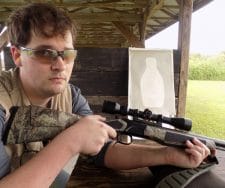
Terril Hebert is a firearm writer native to south Louisiana. Under his motto-Guns, Never Politics-he tackles firearm and reloading topics both in print and on his Mark3smle YouTube channel, where he got his start. Terril has a soft spot for ballistics testing, pocket pistols, and French rifles. When he is not burning ammo, he is indulging his unhealthy wildlife photography obsession or working on his latest novel. Scourge of God, published in 2017. See more from Terril on youtube under Mark3smle

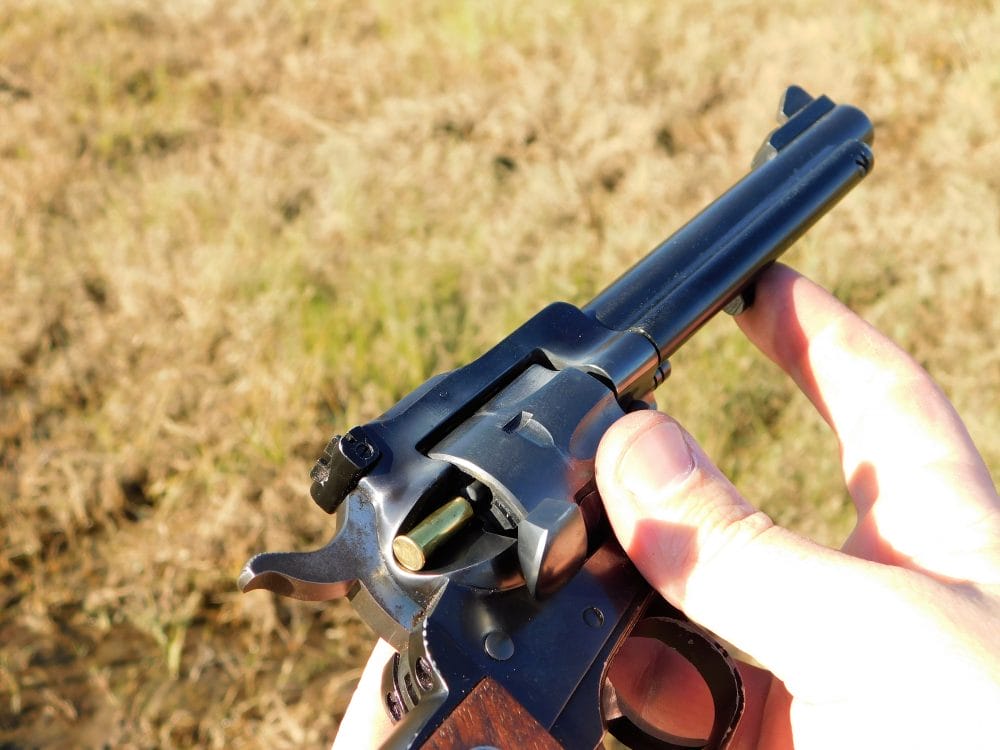
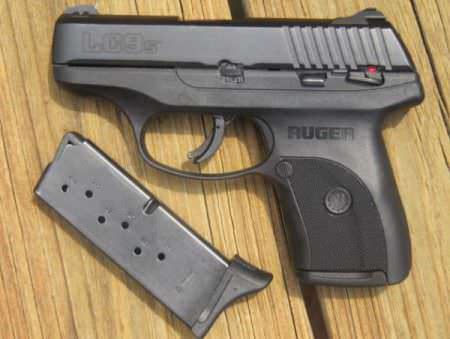
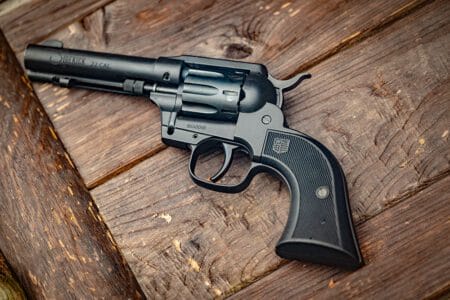
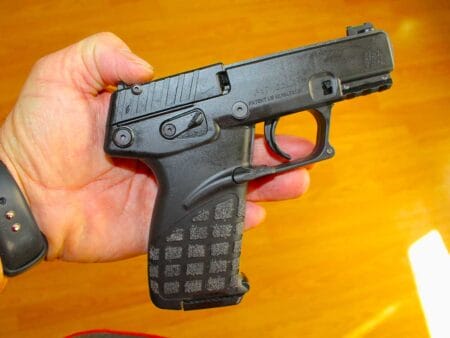

Have a single six that went underwater during Hurricane Katrina. A rusty piece of metal. Sent it back to Ruger. Came back 8 weeks later completely repaired and reblued. No charge. Ruger is number one in my book.
I learned to shoot with my Dad’s Single Six when I was nine years old. I inherited this great cowboy pistol after my Dad passed. I’m 70 years old now and it seems like yesterday I was shooting this pistol with my Dad at the Lake Hefner dam in Oklahoma City. I’ll pass this pistol on to my son after I leave this earth.
Great wheel gun, for sure.j
I wanted one for years and a friend wouldn’t sell me his in 2013 (he couldn’t shoot it due to medical conditions) so I bought a Heritage Rough Rider instead. I went to help my 83 year old friend on Monday and as I left, he gave me the Rough Rider and western holster outfit to remember him by. It was made in 1989 and it had shot less than a box of ammo. I have shot a couple of hundred rounds through it and it is flawless and accurate. I plan on my grandson (also my friend’s grandson) getting… Read more »
my very first handgun purchase just out of high school, my dad had to sign for me. it is a stainless super single six with 22lr ans 22magnum cylinders. an extremely accurate and fun to shoot pistol. most accurate handgun ive ever held! still have it and its well cared for and holds a special spot in the safe
Wonderful article.
But you didn’t mention the .257 Magnum.
Built on the Single Six frame and nearly as good as a .357 (so they say).
Could make a formidable defense round.
Though not needed.
Bought new in 1978, I’ve taken frogs, fish, squirrels, grouse, rabbits, woodchucks (75 yards with .22wmrf), fox, coyotes and one bear. Probably forgot some.
Last gun i would ever sell.
I learned to shoot with an Alloy Single Six that the rear sight was missing. So basically learned early to point shoot handguns before I ever had anything better. Still have that Alloy Six, still missing the rear sight.
My first handgun was a “Super” Single-Six Convertible with a 6 1/2″ barrel which I purchased new in 1968. The “Super” designated adjustable sights. Man, I loved that gun. Unfortunately, family responsibilities interfered and I foolishly sold it about 10 years later. After the kids were grown and gone I got back into guns and one of my first had to be another single-six. It cost about 7 times what the first one did and had cheap plastic grips (which I replaced with walnut) but still has that same feel of solid quality which I’ve come to expect from Ruger.… Read more »
I had a stainless steel single-six in the late 90’s. Unfortunately had some difficult times & had to sell it. Recently, while browsing a local gun shop, I spotted a used one identical the one I had. Of course I couldn’t let it pass, had to bring it home. I never liked the feel of the walnut grips so I changed to a Pachmayr grip (just like my old one). It came with the original hard case, extra mag cylinder, & paper work. Turns out the gun is 10 years old, but still shoots like brand new. I always take… Read more »
My father bought 4 Ruger Single Six in the late 70s. A 22/22mag.,a 357mag. Old Style, (we got the free conversion & put a Pachmyr grip on it) a 44mag. Blackhawk and a 44mag. blackpowder Blackhawk. He taught me how to shoot with each of those beauties, graduating up in caliber as my skills improved. The 357 was smooth as butter and the blackpowder always drew a crowd at the range. I cherished our times there and credit my dad’s teaching and Bill Ruger for making me an expert shot.( according to the medals I earned in the Marine Corps… Read more »
I inherited a 3-screw .22 Mag w/ a 5-1/2″ bbl. and bought a 1976 manufactured .22 LR/.22 Mag convertible with a 6-1/2″ bbl. Both of them are a lot of fun to shoot. I called Ruger about the .22 mag and asked them about a conversion cylinder for it. At the time, they quoted me $60, fitted to the pistol. Then the nice lady said because it was a 3-screw, they would have to do the conversion if I sent it in. I asked her what that entailed and she told me, but said all the old parts are returned… Read more »